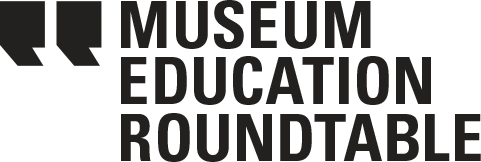Future Forward: Towards a Racially Inclusive Museum
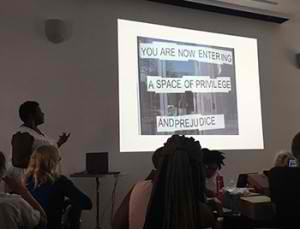
This year’s annual MER Forum held in Washington, DC at the Phillips Collection, was an interactive workshop led by new MER Board member and consulting curator and inclusion specialist, Porchia Moore. Future Forward: Towards a Racially Inclusive Museum was designed as a primer on race and museums, and forms the basis of her doctoral work at the University of South Carolina. The MER Board asked Porchia to guide this workshop as part of our ongoing goal to create meaningful, impactful dialogue around the growing topic of diversity and inclusion within 21st museums.
The Primer
In an effort to provide language tools for which everyone might be able to enter, access, and take part in the discussion, I began the workshop by establishing some fundamental guidelines for how participants might discuss race and museums. I conceived of the workshop as a foundational work and discussion space where museum professionals could flesh out and identify their perspectives and comprehension of issues of race, equity, diversity, and inclusion as practices of 21st century museum work. Primers provide fundamental basics for learning environments, in particular, for the foundation of language and key concepts. As such, I designed the MER Forum as a language primer to introduce fundamental terminology, key concepts, and language re-frames regarding race and museums.
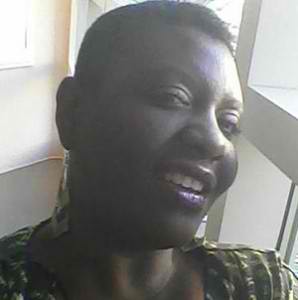 One of the more difficult, yet necessary, of these tools was to introduce the concept of white fragility. Within anti-racist and anti-oppression frameworks, one of the core rules for dialogue is maintaining that it not be the work of participants of color to emotionally take care of their white counterparts. In pop culture, this has been jokingly referred to as “white tears” syndrome. I explained that this rule is set in place not to deny or invalidate genuine feelings of one group but to function as a type of restorative motion. In the context of our discussion on museums, in fact, on any discussions on race, this action is necessary. If this understanding is not set, oftentimes what occurs is that rather than focusing on the lived experiences and traumas of people of color when talking about racism, the focus is placed on the host of emotions that white people go through when confronted with racism and no real work can be done.
One of the more difficult, yet necessary, of these tools was to introduce the concept of white fragility. Within anti-racist and anti-oppression frameworks, one of the core rules for dialogue is maintaining that it not be the work of participants of color to emotionally take care of their white counterparts. In pop culture, this has been jokingly referred to as “white tears” syndrome. I explained that this rule is set in place not to deny or invalidate genuine feelings of one group but to function as a type of restorative motion. In the context of our discussion on museums, in fact, on any discussions on race, this action is necessary. If this understanding is not set, oftentimes what occurs is that rather than focusing on the lived experiences and traumas of people of color when talking about racism, the focus is placed on the host of emotions that white people go through when confronted with racism and no real work can be done.
New Dimensions in Museum Praxis
Increasingly, in what I have called the Inclusive Museum Movement, much of the transformative work being called for is that 21st century inclusive museums operate within principles of intersectionality, acknowledgement of legacies of oppression and privilege, and equity of access predicated on values of social justice. As such, during the workshop, I advocated for a new ecology within museums. In short, these are new dimensions of museum praxis and certainly new, powerful dimensions which extend beyond the historic, often narrow movements of discussions around diversity within museums. For example, in this new ecology, I asked participants to undertake an examination of institutional language and posture, a review of racially inclusive social media platforms, and an assessment of the ways in which equity of power, voice, and space-making is created through major components such as programming, marketing, and exhibitions. The primer introduced key terminology and what I define as the “language of inclusion”. From there, we created dialogue around specially-crafted interactive exercises. The first two exercises were designed around the concept of the language re-frame. A language re-frame is the act of thinking about the power of words and how to create new ones and/or thinking more critically about how museums currently use words in the context of dialogue and action surrounding diversity and inclusion.
Future Forward
From there, I asked participants to reconcile both their institution’s stance on diversity and inclusion and how it overlaps in any way with their own as a means of helping participants to think more critically about their own praxis and its relationship to whether or not they view themselves as accomplices or allies:
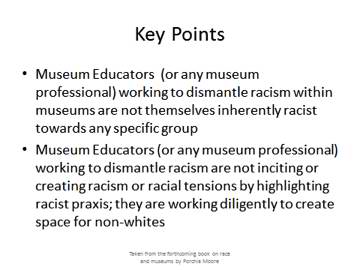
MER’s Journal of Museum Education is publishing a forthcoming special edition on race and museums. A portion of my essay in that edition was used in the Forum and contained several of the following key points as takeaways:
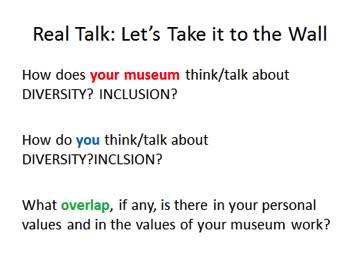
As museum educators, we are not able to think about Diversity and Inclusion within museums as an add-on or last minute item to check off of a list. More than this, our workforce representation, the cultural and information needs of our visitors, requires us to not only create new museum structures which are diverse but to think about how we “practice” diversity. In all, Diversity and Inclusion is a systematic process of space-making. As we already look with excitement and passion towards the annual meeting of the American Alliance of Museums, I encourage readers as I encouraged Forum participants to think more carefully about cultural competence as an integral part of inclusion practices. I look forward to this future.
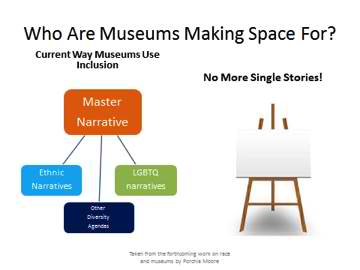
For more information on the MER Forum, my work, or to chat on museums and race, please feel free to contact me at [email protected] or follow me on Twitter @PorchiaMuseM
____________________________________________________________________________
Porchia Moore is a new member of the MER Board and an ABD (All But Dissertation) PhD candidate at the University of South Carolina in the School of Library and Information Science and the McKissick Museum Management program. Her research interests include racial inclusion, community engagement, critical race theory, convergence issues in 21st-century cultural heritage institutions, representations of racial identities in the digital landscape, and LIS curriculum reform. She serves on the Professional Development Committee for the South Carolina Federation of Museums and is a board member for the Friends of African American Art Committee at the Columbia Museum of Art. She regularly presents internationally at both museum and library conferences and is a regular contributing writer for The Incluseum.
Opening photo credit: @interpretkate via Twitter
